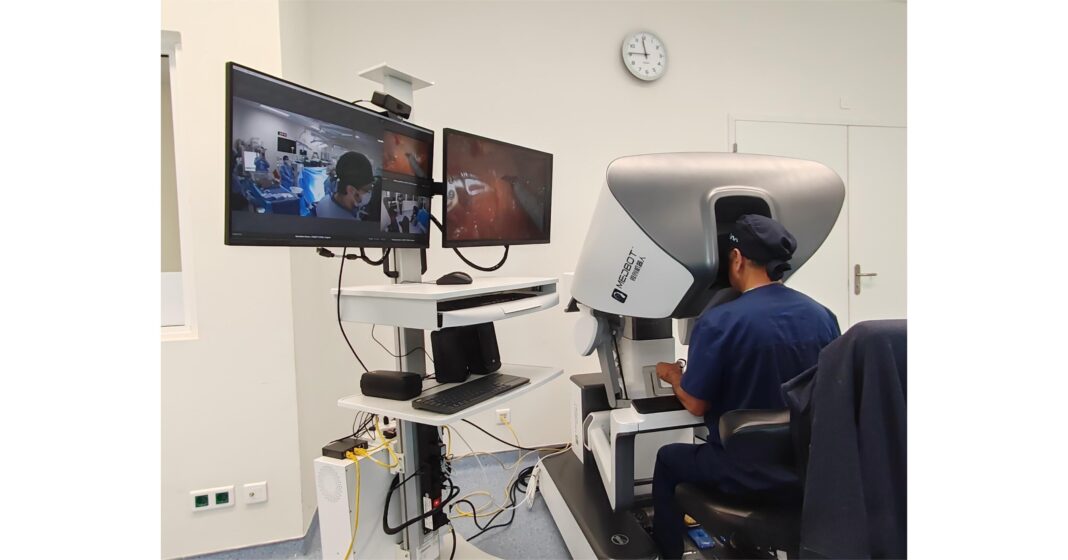In 2025, telesurgery—remote surgery using robotic systems—has made significant strides, enabling surgeons to operate on patients thousands of miles away with unprecedented precision. A landmark achievement occurred in June 2025, when a Chinese surgeon in Rome performed a prostate cancer surgery on a patient in Beijing, 8,000 kilometers away, using the da Vinci Surgical System and 5G technology. This milestone, alongside other recent developments, highlights the transformative potential of telesurgery in bridging healthcare gaps.
What is Telesurgery?
Telesurgery allows a surgeon to control robotic arms equipped with surgical instruments and cameras from a remote console, performing complex procedures on a patient in a different location. Systems like the da Vinci 5, the latest iteration of the da Vinci platform, feature high-definition 3D vision, articulated instruments for enhanced dexterity, and haptic feedback for tactile precision. High-speed networks, particularly 5G, ensure low-latency data transmission, critical for real-time operations. The surgeon views a magnified surgical field and manipulates the robotic arms, making telesurgery nearly indistinguishable from in-person procedures.
The Rome-Beijing Milestone (In 2025, MicroPort MedBot used for Telesurgery)
Dr. Zhang Xu, a urologist from the People’s Liberation Army General Hospital in Beijing, performed the world’s first transcontinental robotic prostatectomy from Rome, Italy, on a patient in Beijing, China, 8,000 kilometers away. Conducted live during the Challenges in Laparoscopy and Robotics & AI conference, the procedure used a da Vinci system connected via 5G, achieving a latency of 135 milliseconds—below the 200-millisecond safety threshold for telesurgery. This success, broadcast to global experts, showcased the feasibility of long-distance, high-precision surgery, with no delays or errors.
Technological Advancements
The da Vinci 5 robot, highlighted in 2025 for its use in training and surgery, enhances telesurgery with features like autonomous camera adjustments and AI-driven learning from surgical data. For instance, Dr. Ali Ahmad at Ascension Via Christi’s Saint Francis Hospital in Wichita, Kansas, used the da Vinci 5 to train surgeons globally, demonstrating its role in both patient care and education. The integration of 5G networks, with ultra-low latency and high bandwidth, has made such procedures viable, reducing the reliance on costly fiber-optic lines used in earlier telesurgeries like the 2001 Operation Lindbergh.
Global Applications and Training
Telesurgery is expanding healthcare access and surgical training. In 2025, Dr. Vipul Patel’s training facility in Florida connected to robotic systems in Brazil, Kuwait, Angola, China, and Morocco, enabling real-time coaching during telesurgeries. In 2023, Patel performed five robotic prostatectomies in China over 5,000 kilometers, testing system reliability with on-site surgical teams as backups. These efforts highlight telesurgery’s potential to deliver expertise to underserved regions, reducing patient travel and wait times.=
Benefits and Challenges
Telesurgery offers significant benefits, including access to specialized care in remote or disaster-stricken areas. For example, a 2025 cardiac telesurgery in India connected Gurugram to Bengaluru over 2,000 kilometers, proving that geographic barriers are diminishing. Patients benefit from minimally invasive procedures, faster recovery, and reduced costs from travel. However, challenges include high equipment costs (da Vinci systems cost ~$1 million), cybersecurity risks, and the need for reliable networks. Legal and ethical issues, such as liability for technical failures, also require global standards.
Future Prospects
The 2024 Rome-Beijing surgery and other 2025 developments signal a future where telesurgery becomes routine. The NHS in England plans to increase robotic-assisted surgeries to 500,000 annually by 2035, with 90% of keyhole operations using robots, indicating global adoption trends. Emerging AI applications, like those in the Smart Tissue Autonomous Robot (STAR), suggest a shift toward supervised autonomy, potentially reducing human intervention. However, experts emphasize that human judgment remains critical, as robots cannot yet adapt to anatomical variations.
Conclusion
The 2024 Rome-Beijing telesurgery and 2025 advancements, such as global training programs and NHS initiatives, underscore telesurgery’s potential to transform healthcare. By leveraging robotics, 5G, and AI, surgeons can deliver precise care across continents, as seen in Dr. Zhang’s milestone procedure. While challenges like cost and connectivity persist, the ability to bridge healthcare gaps in remote areas and enhance surgical training marks a new era. As technology evolves, telesurgery could become a cornerstone of equitable, high-quality medical care, redefining the boundaries of medicine.





